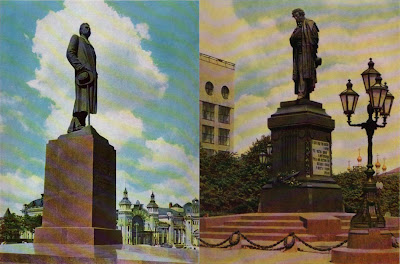

It’s fascinating to discover that many of the artistic avant-garde heroes and heroines of pre-Revolutionary Constructivism survived and went on to work for the state deep into the Stalinist era. El and S Lissitsky and A Rodchenko and V Stepanova consolidated their experimental graphic techniques in a series of propaganda publications in praise of Soviet achievements throughout the Twenties and Thirties. It took the cataclysm of the Second World War to finally sever all links between Modernism and the Soviet state. The post war visual language was profoundly conservative, calculated to reflect the power of the centralised state, and projected a sense of monumentalism and stability appropriate to a regime which placed control over all other values.



Moscow under Reconstruction was published in 1938 in a wonderfully elaborate production designed by Alexander Rodchenko and Varvara Stepanova in which the dynamic quality of urban life were conveyed via a sequence of photographic panoramas, montages, cutaways, fold-outs, and keyhole flaps which open to reveal details of following pages. The images on display here come from 1957, nearly twenty years and one world war later. This book, a simple large format picture book of Moscow, has minimal captions and no other text. The city portrayed is a sober, orderly and visually dull conurbation bathed in pallid sunshine. Massive, ponderous buildings dwarf the thinly spread human population and vast boulevards accommodate little more than a trickle of traffic. All is clean, free of litter and clutter and seems a world away from the frantic motion and dynamic energy of the city as visualised by Rodchenko and Stepanova.



The limitations of the colour process and printing contribute to the lack of definition and naturalism but they cannot be blamed for the pictorial conception which seems designed to convey an image of an ageless and eternal civilisation destined to endure into a more or less indefinite future. The graphic devices of 1938 have been abandoned in favour of a basic and simple presentation that arises more out of an absence of design than out of positive design decisions. A new conservatism predominates.



Half a century has passed and utopian visions of architectural imperialism are very much out of favour. Documentary photography often acquires additional significance as time passes but these images seem to travel in the opposite direction and take on the appearance of a world that may never have existed in a real sense. The wide open spaces and deep perspectives encourage the imagination to seek explanations for the urban anomalies. After a while they assume a theatrical air, at least one step removed from quotidian reality. Human traces are reduced to unfocused smudges; they seem to be in the city but not of the city. This is a city totally free of commercial branding. The power of the state resides in the monumental architecture and the rooftop sculptures that pierce the skyline. To find a city like this today would require a trip to North Korea.





No comments:
Post a Comment